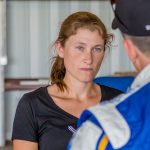SNOW HILL – The parent of an 11-year-old questioned the school system’s practice of surveying middle schoolers regarding sexual activity and drug use this week.
At Tuesday’s meeting of the Worcester County Board of Education, parent Christina Hulslander voiced concerns about the fact that the risk behavior assessment typically given to high school students has in recent years been administered to middle school students.
“I don’t have a problem with this being conducted at high schools,” she said. “They have the maturity to recognize this has value in data collection.”
Hulslander said that when she was notified that her daughter, a sixth-grade student, had been randomly selected to complete the survey, she opted out. Hulslander said she reviewed the survey online and did not like the way the questions, which address topics such as smoking, drug use and sexual activity, were asked. Hulslander said she was concerned that the questions about smoking for instance, could lead to a child wondering whether they should in fact try smoking since they were being asked about it.
“I don’t know this is best for our children,” she said, adding that because the surveys were anonymous students engaging in risky behaviors didn’t necessarily get the resources needed.
When contacted after the meeting, Tamara Mills, the school system’s coordinator of health instruction, said the Maryland Youth Tobacco and Risk Behavior Survey was administered to students every two years. As Maryland is one of 14 states that does give the survey to middle school students, it is administered to randomly selected sixth-, seventh- and eighth-graders at Snow Hill and Pocomoke Middle schools and to randomly selected seventh- and eighth-graders at Stephen Decatur Middle. Mills said the distribution of the survey to younger students had occurred within the past few years. When she asked state officials the reason for the change, they explained that when they’d looked at the results of the high school surveys in years past students had indicated that they’d engaged in the behaviors identified earlier than high school.
“The numbers were high,” she said. “They started these things before high school.”
Mills said that while the questions did address activities such as vaping and drug use, that was because those activities were taking place.
“They try to stay as relevant as they can,” she said.
Mills stressed that parents are able to opt their students out of taking the survey if they’re concerned. While Hulslander said that many parents weren’t aware that they could do that, Mills said the school system did everything it could to notify them. In addition to a letter sent home, the information was posted on the school system’s website. This year the schools also did a robocall to advise parents of the survey.
“We’re going to continue to do that so all parents are aware,” Mills said.
Relatively few parents have taken advantage of the opt-out option.
“We have very few opt-outs,” she said. “A lot of parents realize that even if their child isn’t engaged in these behaviors it’s important to be informed.”
In response to Hulslander’s assertion that anonymous data wasn’t particularly helpful in providing students with resources, Mills said that in 2014 the school system had formed a task force (made up of education and health officials) to review survey results and address any issues identified.
“I feel really good that in the last two years this task force is actually doing something,” she said.
Mills also stressed that the risk behavior survey was just one of the many tools educators used to determine children’s needs.
“We use it as one of the ways to see what positive changes need to be made,” she said. “It’s just one component.”

